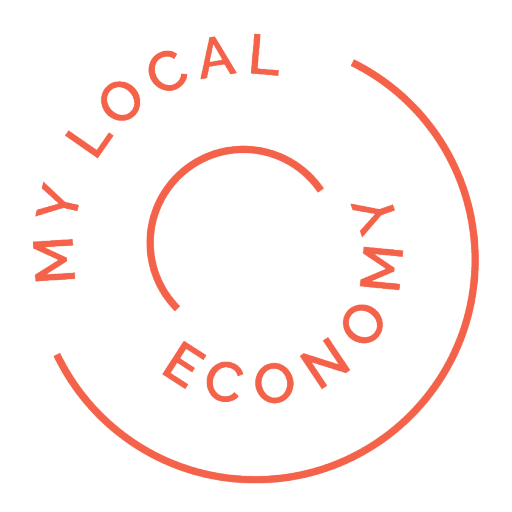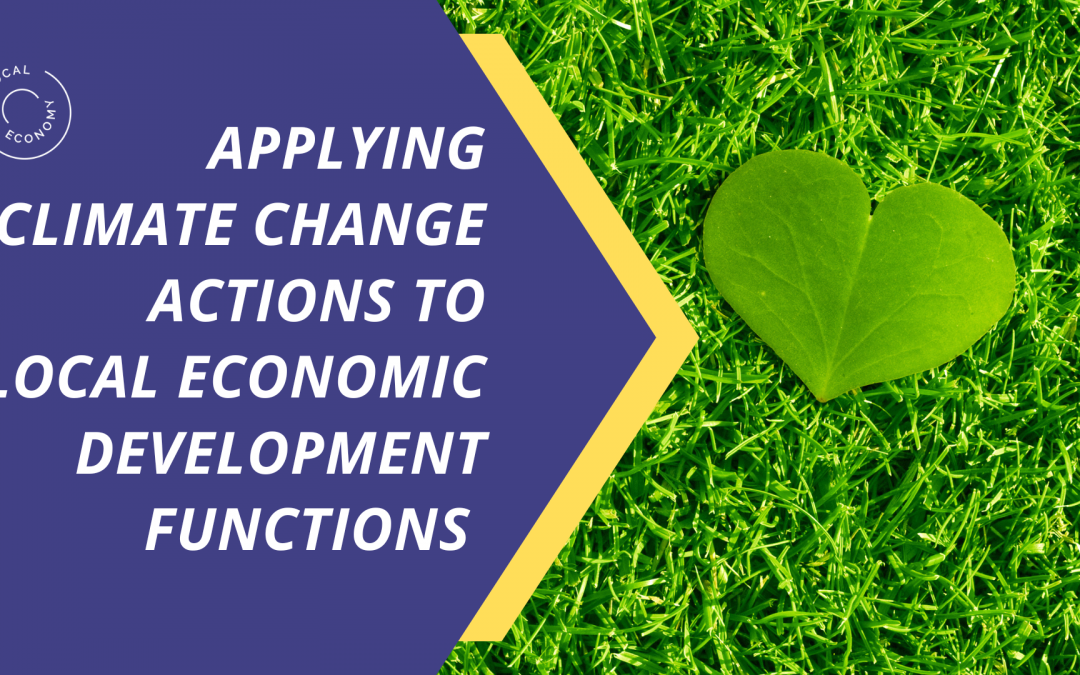Confused by the new models of sustainable development and how to apply them to your local economy?
The more I reflect on my experience over recent years, the more I think that we need to be clearer about what folks should be doing differently with their local economic development strategies and delivery to help address climate change and carbon reduction. Sustainable circular economic models, and doughnut economics – are very useful, but I am guessing that if I have trouble making the leap from these models to mobilising a practical response, and selling it to political and business leaders – then you might too.
In this article – I summarise a longer report I am currently working on with a few insights and illustrations of “what low carbon and sustainability means for local economic development functions.” Hopefully this brief discussion can help to stimulate and inform your thinking about next steps forward.
And – please note – examples of local action are also included. This demonstrates that many cities, localities and territories are getting on with delivering a low carbon, sustainable future – and so can you!
Three founding assumptions
For me – three assumptions are necessary before moving forward. Personally, I think these make good sense:
- The low carbon and sustainability transition is inevitable and that it will heavily influence economic, business, public policy and investment decisions in future.
- Over the medium-to-long term It makes no financial, environmental, economic, social or business sense to continue to promote economic activities and investments that do not support carbon reduction and abatement, or do not operate by sustainability principles.
- The economic development themes I discuss below are not a linear process, but operate in parallel. Your analysis and understanding of your industrial strengths and challenges should inform your vision in terms of the low carbon transition.
Three major drivers
For me, there are three major drivers which mean that we must act now to secure sustainable local economic development strategies:
- Green industries and markets are growing and are well paid – plenty of analysis here.
- The window is closing on winning the big investments and opportunities from Net Zero – as highlighted in the UK Government’s recent Independent Review of Net Zero
- One piece of good news is that we know a lot about low carbon and sustainable solutions – and many are feasible and possible within current technologies and potential market provision. But we need to scale this up and make it the over-riding economic and public policy issue of the next 20 years
Applying climate change and sustainability goals to economic development themes and functions
Below, I’ve summarised some of the main sustainability and climate change transition issues for each economic development function. This gives a flavour for some of the changes in approach that will need to be considered moving forward with local economic development and regeneration policies, programmes and delivery.

Vision, promotion and advocacy
This is a key function that any serious economic development team or organisation should look to provide – but it must be informed by some robust analysis, stakeholder consultation, policy mapping and horizon scanning. It involves getting to grips with your locality as a place, what it offers as a business location and place to invest and visit.
If you can’t articulate a vision about what’s special about your locality, or what you need to change or enhance – then you will have difficulty persuading local residents, businesses, and external investors, including government, to get behind you, adapt behaviours to the new green economy, and help improve the economy. You won’t be able to set effective objectives or goals that people can buy into – to drive your advocacy, resourcing, collaboration or delivery.
The kinds of tasks or priorities that you can address now include:
- Demonstrate how your locality will achieve Net Zero and articulate a vision for your low carbon local economy
- Need to articulate strengths and opportunities in low carbon, environmental goods and services as well as risks and challenges
- Advocate and convince local and national stakeholders and business leaders regarding your local low carbon destination
Examples of local action
The Climate Emergency Skills Action Plan (CESAP) is Scotland’s response to planning for skills to meet the opportunities and challenges of net zero transition. It includes the CESAP Pathfinder Programme: in-depth research on the skills implications of the net zero transition, green occupations, and CESAP sector profiles, with on-going monitoring of CESAP sectors and their changing skills and labour requirements.
Improving local leadership skills and capacity is vital – and there are a number of existing initiatives and examples:
- The Environmental Association for Universities and Colleges Leadership Academy
- The University of Cambridge Institute for Sustainability Leadership (CISL)
- Bristol’s Black & Green Ambassadors Programme
- The NHS Leadership Academy offers a Sustainability Leadership Programme
- Duke University Environmental Leadership Master of Environmental Management degree

Inward investment, promotion, attraction and business retention
Your inward investment offer has to be crafted around your legitimate strengths, offer and potential. Any inward investor will filter whether your proposed site or location is suitable early on. One the one hand, sticking to what are known and demonstrable local strengths and niches. On the other hand – many corporations and the skills and talent they seek to attract are buying into ‘place values’ – in this case, a sustainable place that cares about and is investing in environmental sustainability.
The kinds of tasks or priorities that you may need to address include:
- Occupier-ready sites and premises for green industries and jobs
- Where’s your green niche? Identify and articulate your locality’s skills, capabilities, infrastructure, assets, significant companies, innovations and/or technologies that confer an advantage in low carbon and environmental goods and services
- What are your ‘green place values’ that will help attract corporates and talent? is it public and active transport infrastructure and services, green energy suppliers, major progress on retrofit?
- In the long-term, sites will need to be able to be serviced by green energy, water recycling, and sustainable transport modes. Industrial sites and parks that can incorporate the circular economy will also become required.
Examples of local action
Tyne Powered is the brand concept used to promote the strategic sites portfolio in the North of Tyne area and provides sector-focused brochures for offshore wind and electrification.
Specialist green industry industrial parks are found throughout the UK in places such as Blyth, Stroud, Kent, and Bristol.
in 2022 Glasgow launched its £30bn ‘Greenprint for Investment‘, a portfolio of transformative climate investment projects to boost 2030 Net-Zero goal – a Mix of market-ready opportunities for private capital and radical “unlock and scale” projects developed to appeal to activist investors seeking co-design and longer-term economic partnerships.
Invest in Amsterdam has showcased Circular renovation investments and opportunities.

Infrastructure and transport
Achieving carbon reductions involves using renewable energy which relies more on electrical energy, and less on fossil fuels.
More renewables means more demands on the electrical grid, and the need to significantly expand its coverage and network. As anyone will tell you who has worked in site assembly or inward investment – an empty site isn’t a viable investment or development option unless it is serviced. Electricity grid connections and upgrades can take years to negotiate and deliver.
The kinds of tasks or priorities that you may need to address include:
- Lobbying for and ensuring that enhancements to the electricity grid and network can support your key employment sites
- Sustainable transport is also a must-do for any locality serious about climate change. This must be a blend of public transport, active travel, and provision for vehicles that can use alternative fuels, or electric vehicles
- To future-proof economic plans, strategies and growth – they will need to align with sustainable infrastructure and transport provision and needs
- Infrastructure and transport plans that are not sustainable or utilize much lower or zero carbon emissions are unlikely to receive public funding or planning permission in future
- Permitting non-sustainable transport investment now may be reinforcing locational choices and economic structures which are not viable in the long-term
Examples of local action
Puertollano, Spain is home to a 100 MW solar farm and Europe’s largest green hydrogen facility for industrial use (Iberdrola).
Milton Keynes has prototyped innovative wireless charging technology for a fleet of eight electric buses, in a joint venture project with Arup and Mitsui.
In 2007, the City of Copenhagen introduced “Eco-Metropolis. Our vision for Copenhagen 2015”, which aimed to achieve a 50% bicycle share in commuting to workplaces and educational institutions by 2015.
Toyota’s Woven City, being constructed in Japan is a prototype settlement for 2,000 residents with organic grid pattern to help accelerate the testing of vehicle autonomy, and relies exclusively on hydrogen power.
Section 1-92 of the Illinois Power Agency Act allows a municipality or county to negotiate for the purchase of the combined electric supply of its residents and eligible small businesses. Alternative Retail Electric Suppliers (ARES) have the option to offer “green” products to customers, in which the supplier buys renewable energy credits (REC) to offset energy usage.
Smart Cities Innovation Framework Implementation (SCIFI) is an EU-funded project built around the use of open data to solve urban problems such as transportation, waste management and maintenance of infrastructure. SCIFI aims to design and establish an innovation framework for collaboration across partner cities; and between public service providers, citizens, innovators and experts.
MeerEnergie – is an Amsterdam-based cooperative that plans to use excess heat generated by IT servers in Amsterdam’s Science Park to provide heating and warm water to more than 5,000 homes.
Exmouth Leisure Centre pioneered the use of data centres for heat a public swimming pool. The data centre is part of commercial firm Deep Green’s operations. Hot oil is pumped into a heat exchanger to warm the water in the pool.
The London Local Energy Accelerator (LEA) is a £6m programme providing expertise and support to organisations to develop clean and locally generated energy projects. Projects will include district energy networks that use renewable heat sources (including river water and waste heat from London Underground), and energy technologies such as heat pumps, solar panels, batteries and smart electric vehicle charging.
The MD2700 North London District Energy Network supports the expansion and growth of a district energy network in LB Enfield so that it has the capacity to take up to the 60MW of waste heat that will be available from Edmonton Energy Recovery Facility and the potential to supply at least 20MW of that heat to the boroughs of Haringey and Hackney. £1.2m of grant will enable the supply of near zero carbon heat to at least 8,000 homes in Hackney and Haringey, in addition to 15,000 in Enfield, once the facility is operational.
Energy4All supports a family of 30 independent renewable-energy co-operatives (10 solar PV sites, 12 wind sites, 6 hydro sites, 1 biomass site and Energy Prospects), with 17,308 individual members.

Real estate and regeneration
The Institution of Engineering and Technology reported in 2020 that domestic energy consumption accounts for about 30% of the UK’s total energy budget, and 20% of UK greenhouse gas emissions.
Since 80% of the homes we will be living in by 2050 have already been built, a nationwide programme of deep retrofits and refurbishment of the existing stock is the only way to deliver the required carbon savings.
The kinds of tasks or priorities that you may need to address include:
- Know the retrofit needs, solutions and volumes in your locality
- Design and enforce strict construction, building specification, energy use and service standards
- Consider the sustainability and climate impacts of new developments, extensions and building conversion and re-use
- Extensions of existing sites are likely to be be more sustainable and viable than greenfield sites
- Consider and promote biomass buildings where suitable
- Devise financial tools for retrofit and biomass building finance
Examples of local action
Net zero and low carbon construction initiatives and projects include Leeds’s Climate Innovation District, Freiburg’s Vauban neighbourhood. There are many examples of sustainable construction, Passivhaus construction, and timber construction.
Sustainable and circular economy industrial parks include:
- ECO3, located in the city of Nokia in Finland, is a 150 hectare industrial scale bio-economy and circular economy business park with 28 participating organisations which pioneers bio-, circular- and water- economies.
- Mo Industrial Park (MIP) is one of Norway’s largest and oldest industrial parks, with metallurgy and steel production as its core business, now utilising local hydroelectricity, and implementing a comprehensive programme for recycling energy, by-products and waste.
- Herøya Industrial Park, Norway, is home to 80 different global and local companies in the processing industries, R&D, and chemical industries, as well as several service companies. A range of circular pilot projects have been successfully implemented, including a new separation technology for rare earth elements (REE).
The Mayor of London’s RE:FIT and Retrofit Accelerator: Homes have established Office for Government Commerce registered framework suppliers for commercial and domestic retrofit which are available for use by any public authority in the UK.

Industrial sectors and markets
Some businesses and sectors will face significant challenges and costs in transitioning to net zero – particularly energy-intensive industries. Net zero also has significant transformational and structural challenges for the foundational economy, such as in health, social care, retail and consumer services – which employ a large workforce.
You should already be asking:
- Which businesses face a major energy transition?
- Which industries face drastic restructuring?
- During and after the low carbon transition, where will be the major sources of jobs growth… and decline?
The kinds of tasks or priorities that you may need to address include:
- Identify your most energy intensive industries and firms. Conduct a review of their current plans and adaptation for a low carbon future. Manufacturing firms, in particular, should be a focus.
- Consider the role of the foundational economy. Examples of the foundational economy are care and health services, food, and housing.
- Land-based and agricultural industries are important to think about, as are rural communities. Given their use of fossil-fuels and energy, less dense transport networks and availability of public transport and other infrastructure – they require careful consideration, and perhaps a strategy of their own.
Examples of local action
The National Manufacturing Institute Scotland has a net zero focus aimed at new product development, lightweighting, near net shape manufacturing, remanufacturing, resource efficiency and skills.
Circular Yorkshire is a campaign to raise awareness and inspire action around the circular economy as a way to make our region, its businesses and communities greener, fairer and stronger. Delivery includes circular economy workshops, developing knowledge, advice and tools.
ReLondon’s Business Transformation programme is nurturing a vibrant ecosystem of circular businesses, supporting jobs and resilient economic growth in London. ReLondon’s SME support programme Business Transformation helps companies either adopt circular practices, or – if they already have a circular business model – mainstream and scale their business. Since 2017, ReLondon has offered advisory and matchmaking services to over 350 SMEs and supported the launch of more than 80 circular products, processes or services
Biodiversity enhancing solar farms have been designed and implemented by organisations such as Eden Renewables, with each solar farm designed with a bespoke, progressive ecological and land management plan to create wildlife havens.
Cumbria Sustainable Tourism Toolkit provides help for businesses to understand more about more sustainable working practices and develop new unique selling points.
Destination net zero Programme (Scotland), Highlands and Islands Enterprise offers support to the tourism industry by funding for low carbon buildings and retrofits, EV, cycling and charging infrastructure, and net zero action plans for visitor destinations.

Innovation, entrepreneurship and business growth
New businesses, innovations, products, services and technologies will be required to meet the net zero challenge, and to find new solutions. Green innovation comprises all type of innovations that contribute to the creation of key products, services, or processes to reduce the harm, impact, and deterioration of the environment at the same time that optimises the use of natural resources.
The Energy Systems Catapult’s Innovating to net zero report modelled hundreds of potential pathways to 2050 – ramping up or down different technologies and behaviour changes – to understand the combinations, interactions and trade-offs of competing decarbonisation approaches. Its main finding was that achieving net zero by 2050 depends on innovation across the whole system – technology, land use change and behaviour.
The kinds of tasks or priorities that you may need to address include:
- Analysing your localities main innovation assets, capabilities and strengths, and supporting those that are an advantage in securing green economic growth and jobs as well as helping the local economy adapt and restructure into a low carbon future
- Understanding the innovation and new business opportunities which existing local industries and businesses are well placed to adapt or tap into
- Initiatives to encourage innovation in green solutions to both market and public sector transition needs
- Initiatives to encourage collaboration across industries and technologies to build new disruptive solutions
Examples of local action
Cambridge Cleantech (CCT) connects SMEs, investors, corporates, and academics for a smarter, more sustainable future. Founded in 2011, we are the UK’s leading cleantech cluster firmly embedded in the Cambridge, national – including London and Oxford – and international technology eco-systems. The network runs meet the buyer and investor events, and advice on business growth and internationalisation.
SCALE-UP is a collaboration between existing, successful regional cleantech clusters in Europe. It gives an opportunity for our members to tap into cleantech clusters all over Europe, including Cambridge Cleantech, Clean Copenhagen, Clean Tech Delta, Rotterdam, Cleantech Flanders, EE.SH North Germany and Cleantech Inn Sweden. SCALE UP has successfully connected more than 500 innovative SMEs to corporate buyers since 2017.
Future Technology Centre for Low Carbon Vehicles (LCVs), Washington, Sunderland. Developed by Zero Carbon Futures and managed by Gateshead College, it offers offices, research and development space, manufacturing facilities, training and classroom space as well as proximity to a dedicated LCV performance test track. Tenants include Zero Carbon Futures.
Renowned cleantech and sustainable business accelerator programmes include Climate-KIC Acceleration Programme (operates in Berlin, London), LaunchNY’s ECO Incubator Programme (New York), Urban Future Lab (New York), Cleantech Open (global), Greentown Labs (Boston, MA), and Powerhouse (Oakland, California).
SET Squared is run by the Universities of Bath, Bristol, Cardiff, Exeter, Southampton, and Surrey – and offers scale up support for SMEs involved in sustainable technologies.
Future Business Centres in Cambridge, East London and Peterborough. Established and run by a social enterprise, Allia, these business incubators are aimed at supporting businesses that have an environmental social or community purpose. This includes charities and social enterprises, as well as low carbon and green businesses.
Orbis Energy in Lowestoft provides incubators, managed workspace, follow-on premises for offshore energy sector including wind energy.
The East of England Low Carbon Innovation Fund (LCIF) is a venture capital fund offering investment in low carbon enterprises, technologies, goods and services.

Labour participation and ‘just transition’
The response to climate change will require some sweeping changes to energy costs and use, transport networks and availability, market demand and supply chains.
There are real risks that the transition to net zero could add extra cost burdens onto low income residents and neighbourhoods, selected employers (particularly those reliant on road transport and are energy intensive), and that there could be job losses as part of the economic restructuring that occurs.
Without a Just Transition, many workers, particularly those in the oil and gas sector, will lose their livelihoods creating unnecessary hardship for them and their communities. As the transition picks up speed, the location of job losses and employment gains is receiving increasing attention, in the need to avoid ‘stranded workers’, ‘stranded communities’ and ‘stranded countries’, as well as to make sure that new green jobs are also quality jobs.
The kinds of tasks or priorities that you may need to address include:
- Research and identification of industries, workers and communities most at risk from the low carbon transition.
- Identify forms of green jobs and transition that would have a positive impact on poverty, health, and neighbourhood inclusion. Community energy and sustainability may be a useful focus.
- Put in place counselling, guidance, training and work experience services to enable disadvantages or displaced workers or residents to access green employment opportunities.
- Just transition as a process. The key ingredients of what makes for a just transition are well established and will need to be followed: social dialogue in the workplace, along with respect for labour standards and human rights, economy-wide skills development and retraining, buttressed by social protection and safety nets.
Examples of local action
The Let’s Do net zero: Off Electricity Grid Communities Fund aims to decarbonise and future-proof the existing local independent electrical grids of those communities that are not connected to the national electricity grid in Scotland. The support available from the Scottish Government’s Community and Renewable Energy Scheme (CARES) will help these communities to work towards becoming net zero communities. With more resilient infrastructure these local grids will be able to provide reliable power and be on a path to supporting the decarbonisation of heat.
The Construction Scotland Innovation Centre (CSIC) Low Carbon Learning programme created a training course to equip construction workers with the skills to retrofit buildings for a low carbon future. The course is aimed at construction workers who are out of work or facing the prospect of redundancy.
Hounslow’s Green Recovery, Green Academy Programme aims to provide green skills training and upskilling opportunities to everyone, but especially those most at risk of unemployment. It helps supply the green technicians, graduates and operatives needed to fuel the local Green Enterprise Zone and to attract organisations to the borough and build more employment opportunities.
Scotland’s Transition Training Fund. £12m Transition Training Fund set up by the Scottish government and managed by Skills Development Scotland offering support with grants to retrain and upskill workers from the declining oil and gas industry.

Skills
STEM skills lie at the heart of skills needs for the green economy and transition to net zero, particularly for entry-level jobs, and for roles that employers can shape and train themselves.
Some industries are relatively well established, and skills needs are known, such as for offshore wind energy, EV manufacture, and construction retrofit. But for other sectors and aspects of the low carbon transition, we do yet not know the nature of skills demand, or the pace and scale of transition and change required for industrial transformation and skills transformation. This will require some kind of agile skills fund or programme that can adapt and grow as needed.
The kinds of tasks or priorities that you may need to address include:
- Analyse and anticipate likely future green skills needs
- Map out existing green skills courses and providers, identify gaps and where integration needs to be improved
- Anticipate future careers in green industries, and have guidance materials and services ready
- Establish core foundation skills provision and funding – for entry-level skills, that employers can build on with their own training
- Put in place agile skills funding programmes that can meet future skills needs as they emerge
Examples of local action
The Green Growth Foresighting Project is being led by Newcastle College and seeks to understand the current and future skills needs of leading green industries including offshore wind energy and EVs.
The Energy Skills Partnership, Scotland is a collaboration of Scotland’s colleges and industry partners established to increase delivery of green skills needed across energy, engineering, and construction sectors. The partnership is working to align skills supply with 17 new offshore wind projects approved for development in Scotland over the next ten years.
The Green Jobs Workforce Academy offers information on available opportunities and the skills needed, along with details on required training and funding sources. It also has in-depth information available on the green jobs sectors including renewables, transportation, construction, engineering, agriculture and land use. Establishing the academy was one of the key aims of Skills Development Scotland from its Climate Emergency Skills Action Plan which was published in December 2020.
London’s Climate Kick-Start programme targets secondary school pupils in the UK capital, focusing on inspiring young people to pursue green careers, with the scheme supported by Bloomberg L.P. and Let’s Go Zero 2023. In addition, a ‘green careers’ toolkit will be created for all secondary schools in London, containing advice and tips relating to green jobs. Information will also be available on which subjects to study for which roles, and how these can help safeguard the environment.
Retrofit skills bootcamps, such as those funded by NTCA and provided by RE:GEON offer specific training in new areas such as Construction Green Skills. Bootcamps take an employer-led approach and have achieved high success rates in placing participants into jobs.
Greater Manchester’s Green Skills Academy houses the latest green technology equipment in order for businesses and individuals to gain knowledge and skill – including air source heat pumps installation, solar photovoltaic panel installation, inspection & testing, wind turbine installation, EV charging point installation, external wall insulation, smart home programming system, and cavity wall insulation extraction.
The Prospect Union worked with the EDF regarding the Cottam Power Station in Nottinghamshire which was scheduled for closure, to explore ways to transfer across workers to other parts of the energy sector – retaining these workers and their skills. This resulted in workers being able to move across to similar roles in nuclear and renewables. Here workers would pick up the additional technology-specific skills as part of their induction.
Please send links to good examples of local practice
Finally – if you have some good examples of local and regional practice and progress – please share. I’ll put them into my longer report, which will be freely available once published.

About Glenn
Glenn runs his own consultancy, Mylocaleconomy. We help local leaders translate their economic ambitions into winning advocacy and solutions that get funded. We work all over the UK – from the Highlands of Scotland to Wales, Bristol, Teeside, North East England, Gloucestershire, London, Cambridgeshire and Sussex.
We love challenging assignments, complex opportunities, intractable problems. Our vocation is to help city, region and local economies succeed and for prosperity to be sustainable and shared.
Get in touch via LinkedIn messaging or the contact form on our website.

